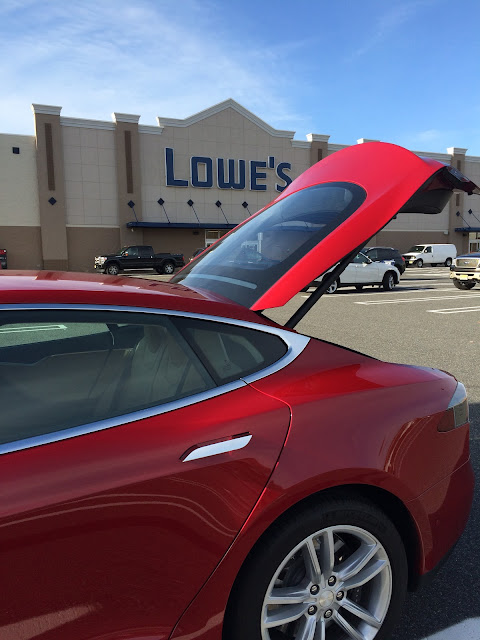 |
| In trying to keep my 2015 Tesla Model S ding free, I usually park far away from the entrance of stores, as I did when I shopped a one-day sale on wine at Whole Foods Market in Paramus, N.J., above. |
By VICTOR E. SASSON
EDITOR
On the way into Whole Foods Market the other day, I saw one of those enormous GMC Yukons that seemed to be wedged in between two other vehicles in the parking lot.
I wondered whether the overweight, middle-aged white guy behind the wheel of the gas guzzler could open the driver's door without dinging the far smaller vehicle next to him.
After I bought a zero-emissions Tesla Model S in April and started enjoying all of its great features -- including its exclusivity -- I started thinking of just about everything else on the road as so many pieces of crap.
What else can you say about gasoline- and diesel-powered cars that use antiquated technology to fill the air with fumes that are slowly killing people and noise that hounds them to their deaths?
I still have a lot of affection for the pioneering Toyota Prius, the gas-electric hybrid I drove from 2004-15 (I owned four, one of which we still have).
And I smile when I see a Nissan Leaf, BMW i3 or other all-electric vehicle. I've actually seen one Mercedes-Benz B Class with a Tesla drivetrain.
But I'm so disappointed the other German companies won't have any purely electric cars for another five years or more.
How arrogant.
Too much noise
And some of the biggest, priciest and most piggish Mercedes-Benzes earn poor marks from Consumer Reports when it comes to reliability.
Another thing that drives me crazy are all those TV commercials that show cars moving at insane speeds on race tracks or across desserts.
Did you see the Infiniti commercial showing a woman backing up the 400-horsepower, bus-like Q80 SUV over deep mountain snow?
Too bad it didn't go over the edge, and take the model behind the wheel with it.
I recently drove a Mercedes sedan, the $40,000 C300, and was shocked by the harsh ride and complexity of interior controls:
Levers, wheels, toggle switches and more, and a back-up camera that can be turned off!
When I pulled the owner's manual out of the glove box, I learned that I would have to refer to a second manual to find out how to turn on the camera.
Near-silent running
Forget about the 0-60 mph time, which the automotive media obsess over.
In the suburban driving I do in northern New Jersey, 0-25 mph, 0-35 mph and 0-40 mph rule the road, and the Model S outperforms nearly everything else.
Is it my imagination that many other drivers want to race the Model S or just annoy me by tailgating?
 |
| I took advantage of a free-coffee promotion at a new Wawa in Hackensack, N.J. |
 |
| Property taxes continue to climb for homeowners in Hackensack, where residents are saddled with three large tax-exempt entities, including Hackensack University Medical Center. |
Boring Buick
On Tuesday, Tony DiSalle, U.S. vice president of Buick and GMC marketing, was scheduled to speak to members of the International Motor Press Association in midtown Manhattan.
I'm a member, but I skipped the program, which included free cocktails and a sumptuous buffet lunch, because what could DiSalle possibly say about the most boring car line in America?
'The charging regime'
I was struck by the accuracy of statements from Jeff Knight of the CAP Black Book in the United Kingdom on the lifestyle of a Tesla Model S owner.
As reported by EV Obsession and Gas2 blogs, Knight said:
"Many Tesla owners alter their lifestyle to fit the charging regime, because they are that passionate about the benefits of their vehicle.
"People clearly love this vehicle, which means it holds its value.
"For anyone looking to buy an executive car with green credentials, but can handle the charging regime, a Tesla is one of the smartest investments in today's market."
Amen.
As reported by EV Obsession and Gas2 blogs, Knight said:
"Many Tesla owners alter their lifestyle to fit the charging regime, because they are that passionate about the benefits of their vehicle.
"People clearly love this vehicle, which means it holds its value.
"For anyone looking to buy an executive car with green credentials, but can handle the charging regime, a Tesla is one of the smartest investments in today's market."
Amen.




























